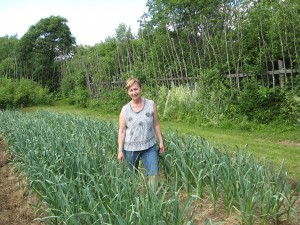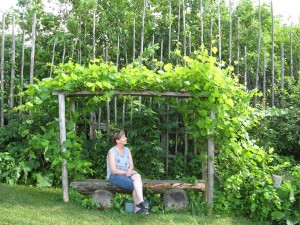The Garlic Garden

So I was quite thrilled when Carol Godbout Kinney invited me out to her beautiful homestead in Kintore to check out her garlic garden.
Carol’s garden is absolutely lovely. It contains a beautiful grape arbor, planted with concord grape vines. Sitting under this arbor was very soothing, cool and serene.
When Joe and Carol first made this garden, they deer proofed it by surrounding it with iron wood saplings nailed to a frame. You can see this in the photos…it works very well and is neat looking as well.
Carol has been cultivating her garlic patch for 20 years. She grows a species called Hard Neck Red Garlic. This type of garlic has, as the name implies, a hard stem, and the bulbs have beautiful red stripes. You can’t braid this kind of garlic into a wreath, for instance…the neck is really that hard. It takes some doing to even saw through it with a kitchen knife.
But the garlic itself has a marvelous flavour, and its texture is smooth and creamy which makes it a lovely addition to sauces.
Every year Carol digs up the crop in late summer . It’s nearly harvest time right now, in fact! She saves some, gives some away to lucky recipients, and replants separated cloves for the next year’s crop.
Not only is garlic an indispensable component in any kitchen, it has been recognized and used for thousands of years as one of nature’s most powerful and effective medicinal aids.
 It was in Sumeria, somewhere around 2300 BCE, that garlic first came into prominence. Archaeologists digging at the ancient sites of Babylon and Nippur found thousands of clay tablets that have provided fascinating glimpses into the lives of the ancients.
It was in Sumeria, somewhere around 2300 BCE, that garlic first came into prominence. Archaeologists digging at the ancient sites of Babylon and Nippur found thousands of clay tablets that have provided fascinating glimpses into the lives of the ancients.
These tablets reveal that garlic was extensively employed to reduce fevers, used in decoctions to soothe loose bowels, as a fomentation for painful swellings, made into a liniment for strained muscles and ligaments, used as a tincture to get rid of intestinal parasites, and simply drunk as a general tonic to feel better.
The magic ingredient in garlic appears to be sulphur. Garlic contains at least 100 sulphur containing compounds, all of which are linked to its wonderful medicinal uses.
These compounds remain relatively inactive when the cloves are left whole. But, once a garlic clove is cut and macerated, it triggers the formation of a cascade of compounds that create its unique healing qualities.
An effective and easy to make relief for insect stings and bites can be made by mashing a garlic clove and mixing it with saliva. The enzymes in our saliva, mixed with the sulphur compounds of the garlic will reduce the swelling and itching.
This is used in Middle Eastern countries even for poisonous scorpion stings.
During both World Wars, garlic was routinely used by military doctors as an antiseptic against gangrene when penicillin wasn’t available. Recent laboratory investigations have revealed that garlic juice inhibits the growth of staph, strep, dysentery and typhoid bacteria!
It is also an effective agent against harmful fungi and Candida albicans, which causes thrush and other yeast infections.
So not only is garlic one of the tastiest foods on this planet, and an absolutely vital ingredient in the kitchen of any cook…. it can also be made into liniments, oils, douches, enemas and pills.
If you can deal with garlic breath, a clove a day does indeed keep the doctor away!
